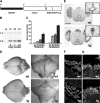Prolonged glial expression of Sox4 in the CNS leads to architectural cerebellar defects and ataxia
- PMID: 17507571
- PMCID: PMC6672350
- DOI: 10.1523/JNEUROSCI.1384-07.2007
Prolonged glial expression of Sox4 in the CNS leads to architectural cerebellar defects and ataxia
Abstract
Sox proteins of group C are strongly expressed in the developing nervous system and have been associated with maturation of neurons and glia. Here, we overexpressed the group C protein Sox4 in transgenic mice under the control of the human GFAP promoter. Transgene expression was detected in radial glia and astrocytes throughout the CNS. The transgenic mice were ataxic and exhibited hydrocephaly as well as cerebellar malformations. In the cerebellum, fissures were not formed and neuronal layering was dramatically disturbed. Nevertheless, all neuronal cell types of the cerebellum were present as well as cells with characteristics of early radial glia, astrocytes, and oligodendrocytes. However, radial glia failed to migrate into the position normally taken by Bergmann glia and did not extend radial fibers toward the pial surface. The cerebellar malformations can therefore be explained by the absence of functional Bergmann glia. We conclude that Sox4 expression counteracts differentiation of radial glia and has to be downregulated before full maturation can occur.
Figures








Similar articles
-
Sox2 conditional mutation in mouse causes ataxic symptoms, cerebellar vermis hypoplasia, and postnatal defects of Bergmann glia.Glia. 2018 Sep;66(9):1929-1946. doi: 10.1002/glia.23448. Epub 2018 May 6. Glia. 2018. PMID: 29732603
-
Prolonged Sox4 expression in oligodendrocytes interferes with normal myelination in the central nervous system.Mol Cell Biol. 2007 Aug;27(15):5316-26. doi: 10.1128/MCB.00339-07. Epub 2007 May 21. Mol Cell Biol. 2007. PMID: 17515609 Free PMC article.
-
Identification of novel glial genes by single-cell transcriptional profiling of Bergmann glial cells from mouse cerebellum.PLoS One. 2010 Feb 12;5(2):e9198. doi: 10.1371/journal.pone.0009198. PLoS One. 2010. PMID: 20169146 Free PMC article.
-
Origin, lineage and function of cerebellar glia.Prog Neurobiol. 2013 Oct;109:42-63. doi: 10.1016/j.pneurobio.2013.08.001. Epub 2013 Aug 25. Prog Neurobiol. 2013. PMID: 23981535 Review.
-
Cytodifferentiation of Bergmann glia and its relationship with Purkinje cells.Anat Sci Int. 2002 Jun;77(2):94-108. doi: 10.1046/j.0022-7722.2002.00021.x. Anat Sci Int. 2002. PMID: 12418089 Review.
Cited by
-
High expression of long intervening non-coding RNA OLMALINC in the human cortical white matter is associated with regulation of oligodendrocyte maturation.Mol Brain. 2015 Jan 10;8:2. doi: 10.1186/s13041-014-0091-9. Mol Brain. 2015. PMID: 25575711 Free PMC article.
-
Sox12 deletion in the mouse reveals nonreciprocal redundancy with the related Sox4 and Sox11 transcription factors.Mol Cell Biol. 2008 Aug;28(15):4675-87. doi: 10.1128/MCB.00338-08. Epub 2008 May 27. Mol Cell Biol. 2008. PMID: 18505825 Free PMC article.
-
Shp2-dependent ERK signaling is essential for induction of Bergmann glia and foliation of the cerebellum.J Neurosci. 2014 Jan 15;34(3):922-31. doi: 10.1523/JNEUROSCI.3476-13.2014. J Neurosci. 2014. PMID: 24431450 Free PMC article.
-
Organogenesis relies on SoxC transcription factors for the survival of neural and mesenchymal progenitors.Nat Commun. 2010 Apr 12;1(1):9. doi: 10.1038/ncomms1008. Nat Commun. 2010. PMID: 20596238 Free PMC article.
-
Over-expression of Sox4 and β-catenin is associated with a less favorable prognosis of osteosarcoma.J Huazhong Univ Sci Technolog Med Sci. 2016 Apr;36(2):193-199. doi: 10.1007/s11596-016-1565-z. Epub 2016 Apr 13. J Huazhong Univ Sci Technolog Med Sci. 2016. PMID: 27072961
References
-
- Baader SL, Bergmann M, Mertz KD, Fox PA, Gerdes J, Oberdick J, Schilling K. The differentiation of cerebellar interneurons is independent of their mitotic history. Neuroscience. 1999;90:1243–1254. - PubMed
-
- Bayer SA, Altman J, Chaper I. San Diego: Academic; 2004. Development in the rat nervous system.
-
- Bermingham JR, Scherer SS, O'Connell S, Arroyo E, Kalla KA, Powell FL, Rosenfeld MG. Tst-1/Oct-6/SCIP regulates a unique step in peripheral myelination and is required for normal respiration. Genes Dev. 1996;10:1751–1762. - PubMed
Publication types
MeSH terms
Substances
LinkOut - more resources
Full Text Sources
Molecular Biology Databases
Miscellaneous
